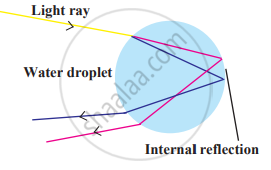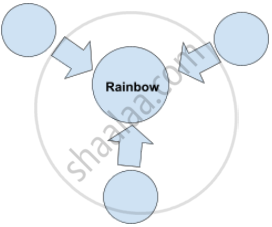Advertisements
Advertisements
प्रश्न
The phenomena of light involved in the formation of rainbow are ______.
Which of the following phenomena of light are involved in the formation of a rainbow?
पर्याय
Reflection, refraction and dispersion
Refraction, dispersion and total internal reflection
Refraction, dispersion and internal reflection
Dispersion, scattering and total internal reflection
उत्तर
Refraction, dispersion and internal reflection
Explanation -
A rainbow is a natural spectrum of seven colours appearing in the sky after a rain shower. It is caused by dispersion of sunlight by tiny water droplets, present in the atmosphere. The water droplets act like small prisms. They refract and disperse the incident sunlight, then reflect it internally, and finally refract it again when it comes out of the raindrop.
संबंधित प्रश्न
Why do the component colours of incident white light split into a spectrum while passing through a glass prism, explain
In the formation of spectrum of white light by a prism:
which colour is deviated most?
Describe how you could demonstrate that white light is composed of a number of colours.
Which of the following coloured light has the least speed in glass prism?
(a) violet
(b) yellow
(c) red
(d) green
A glass prism is able to produce the spectrum when white light passes through it, but a glass slab doesn’t produce any spectrum. Explain why it is so.
An object AB is placed in front of a convex lens as shown in fig. 4. Complete the ray diagram and obtain the image formed and state the nature of the image.

Rainbow is a beautiful natural phenomenon. It is the combined effect of a natural three processes together produced by light. Write it into the circle.


The periscope is an optical device with a polished surface that reflects the light falling on it.
During dispersion of white light by prism placed in air, for a particular value of angle of prism,
